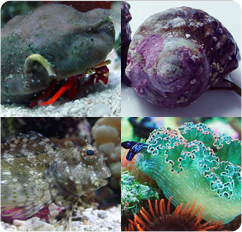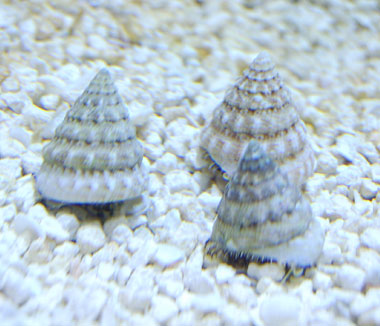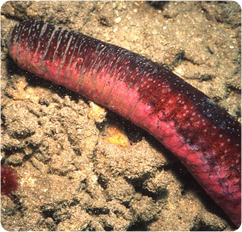|
Tune-Up That Clean-Up Crew
Understand How to Get the Most Out of Your CUC
 |
| Typical Clean-Up Crew Members |
Choosing an initial clean-up crew for your aquarium is relatively easy based on the type of system you have, your maintenance program and the livestock you keep. Keeping your clean-up crew in top form is, on the other hand, far more difficult.
Over time, you will experience clean-up crew losses. That’s just the reality. Some animals will die of natural causes, while others may become snack food for some of your fishes and other invertebrates. In order to keep your clean-up crew in top form, we recommend the following three steps:
- To minimize unnecessary losses, only buy clean-up crew animals that are appropriate for your tank.
- Pay particular attention to the specific needs of your clean-up crew members.
- Regularly bolster and/or adjust your clean-up crew numbers as part of regular maintenance in order to maintain a balanced aquarium.
Appropriate Clean-Up Crew for Your Aquarium
 |
| Trochus snails from the family Trochidae are some of the hardiest of the algae-grazing snails. |
Often people buy clean-up crews without thinking about whether or not the animals are truly appropriate for their system.
As Dr. Ronald Shimek writes in his article “The Grazing Snails” published in Reefkeeping, “Of the common reef aquarium animals, only the polychaete annelids, or so-called bristle worms, are more misunderstood and badly treated than the common snails that many aquarists put into their systems to graze on or remove algae.” As Shimek, a well-respected marine invertebrate zoologist and ecologist, explains, “[r]elatively little thought generally goes into the choice of these animals and…even less thought goes into their care.” At Blue Zoo, we encourage you to approach the husbandry of your clean-up crew animals in the same manner you would any of your other livestock.
One impotant factor to consider is the type of environment your tank is replicating. For example, if you have a tropical reef tank, you should steer clear of non-tropical clean-up crew members. Unfortunately, this is often more difficult than it should be, as snails are frequently sold with no information as to their origin. The reality is that we know of some marine aquarium fish stores collect snails here in Southern California and sell them to people with tropical marine aquaria. Southern California may be sunny, but the water's temperature is far from tropical.
Fortunately, not many professionals in this industry are that unethical, so what you really need to look out for are the so-called sub-tropical snails like margarita snails (Margarites pupillus) and some turbo snails (Turbo fluctuosa) collected in the Eastern Pacific. If the snail is collected in cooler waters than the average reef aquarium—say 76- to 80-degrees Fahrenheit—adding them to a reef tank will greatly shorten their life span. Beyond the ethical considerations, this will necessitate replacing large numbers of your clean-up crew at least every six months, and this adds up in terms of money that could be better spent on other animals or aquarium equipment.
In addition to considering the environmental needs of clean-up crew animals, it’s important to only add clean-up crew members who are compatible with the other livestock you keep. For example, if you have a predator tank (a tank with large predator fishes like Puffers, Triggerfishes, Lionfishes, and large Wrasses), your clean-up crew will most likely be limited to hermit crabs (for detritus and to scavenge uneaten food) and large, hard-shelled snails such as turbo snails (for algae grazing). Adding soft-shelled snails, sea cucumbers, or lettuce slugs as part of your clean-up crew would be a poor choice in this situation. Again, ethics aside, doing so would be a waste of money.
Finally, make sure that you are adding clean-up crew animals to a tank that can support them. Below, we will discuss some specific husbandry requirements in terms of caring for the clean-up crew animals already living in your system, but keep in mind that you should consider the animals’ needs before adding them in the first place. For example, in a properly cycled aquarium with live rock, there should be sufficient algae growth to support herbivorous snails as some of the first additions to a new system. If, however, you just started a system with no live rock or a limited amount of live rock, there may not be enough naturally occurring algae to support the recommended number of herbivorous snails in a typical algae clean-up crew. Adding the “normal” number of herbivorous snails without supplemental feedings would probably lead to starvartion.
The Specific Needs of Clean-Up Crew Members
 |
| Like most starfish, sea cucumbers, like this pink and black sea cucumber (Holothuria edulis), need a long drip acclimitization. |
By paying careful attention to the specific needs of your clean-up crew members, you will find that your clean-up crew is more effective and longer-lived. The first step to adding a successful clean-up crew is to acquire the animals for a reputable retailer. Bringing healthy livestock into your house is all for naught, however, if you don’t take the time to acclimate them properly. Properly acclimating animals such as sand sifting starfish (Astropecten polyacanthus) can make the difference between a long-lived, effective clean-up crew member and a short-lived, ineffective one. The sand sifting starfish needs a long, slow drip acclimatization period of no less than two and one-half hours in order to properly adjust to the parameters in your new aquarium. Sea cucumbers are another group of clean-up crew animals that need long drip acclimitization.
In addition to properly acclimating your clean-up crew, you must also be aware of each animal’s specific needs and husbandry requirements. For example, while your fishes may be fine with a stable salinity in the 1.020 ppm range, the sand sifting starfish discussed above, will be short-lived unless salinity is maintained at a 1.025 ppm.
Many common clean-up crew members do best with (or absolutely require) a sandbed. Without a sandbed, some of these animals may survive, but they will never become truly acclimated leading to a shorter than normal lifespan. In particular, sea cucumbers such as the pink and black sea cucumber (Holothuria edulis), nassarius snails (Nassarius spp.) and the Tonga fighting conch (Strombus gibberulus ) all should be kept in a tank with a sandbed in order to meet their husbandry requirements.
Finally, remember that some species in your clean-up crew may also prey on your other livestock if you do not meet their husbandry requirements. This is a completely different discussion than the one above about not employing clean-up crew members that are incompatible with your other livestock. Here we are talking about clean-up crew members that are incompatible with other clean-up crew animals. For example, at Blue Zoo Aquatics, we highly recommend hermit crabs as part of almost every marine tank’s clean-up crew despite the fact that hermit crabs are known to kill the exact same snails we recommend as being part of the same clean-up crew. Even small Calcinius species of hermit crabs like the blue leg reef hermit crab (Calcinius sp.) are known to kill small snails in order to take their shells. This is a natural part of these animals’ life cycles that the aquarist must understand in order to maximize these crabs’ effectiveness and minimize the potential damage they could do to the rest of the clean-up crew. Understanding this animal’s husbandry needs is just as essential as knowing that a photosynthetic coral needs lights or that a triggerfish needs a cave. Adding empty shells will solve the problem and is certainly much cheaper and easier than providing reef-ready lighting for a photosynthetic coral!
Adding to an Established Clean-Up Crew
Even with the proper livestock selection and excellent husbandry, you will, no doubt, experience clean-up crew losses. Especially in a new aquarium (say less than a year old) or in an aquarium that has recently undergone major changes in livestock, flow patterns or aquascaping, the number of clean-up crew animals required to handle nuisance algae and detritus may also change. The best approach to dealing with these situations is to use careful observation and testing to closely monitor your system. If you see an increasing amount of nuisance algae, for example, you may want to add some algae-grazing clean-up crew animals to your aquarium if all your other parameters (e.g. phosphate, nitrites and nitrates) are consistent. In this situation, it is best to add a few at a time. Shimek suggests adding them until “there is a barely visible film of diatoms on the rocks or aquarium walls [at the end of the day]. [If you have the correct number of grazers] such a film will be gone by the morning, and the snails will keep the diatoms in check henceforth."
Published 29 July 2008. © Blue Zoo Aquatics
|